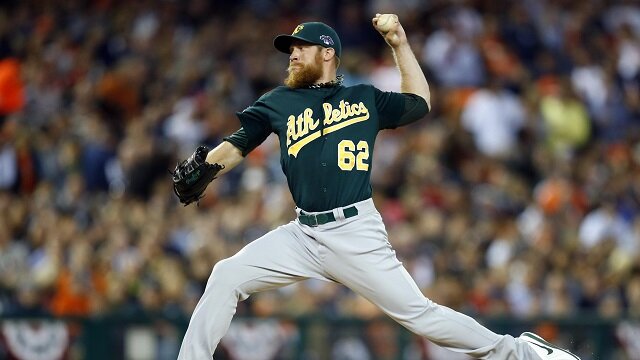Sean Doolittle is already the Oakland Athletics‘ most valuable reliever, and it’s about time that the team gives him a role befitting of his performance.
That, of course, would the the ninth inning, where Grant Balfour has been busy making his living, having taken the job from Ryan Cook back in 2012 and never looking back. In fact, that he’s recorded 62 saves between 2012-2013 may very well be the reason why Billy Beane and co. are likely to part ways with the 35-year old Aussie, who is almost certainly looking for a requisite Established Closer pay raise from his $4.5 million salary this season.
Not that it should worry the A’s much, however, given that they have a duo of ready-made replacements in 1.6 fWAR relievers Doolittle and Cook.
The number, by the way, puts them both among the top-20 relievers in the game this past regular season, sharing a five-way tie with folks like David Robertson and Aroldis Chapman, so it’s not a stretch to say that both have been among the very best in the game — not just on the Athletics.
Still, why choose Doolittle over Cook? There’s certain a pretty good argument for why the team’s ex-closer (14 saves in 2012) should get the first shot at his old job back, and it could also be the case that the team could go with a good ol’ committee. Looking closer at the numbers, however, and you’ll find that the former is the ideal choice.
That seems like a weird thing do say given that Cook actually posted a better ERA than Doolittle (2.54 vs. 3.13) and he actually stuck out more batters as well (8.96 vs. 7.83), but both of those advantages are actually rather deceiving.
With Doolittle owning a slight FIP and xFIP advantage (2.71/3.68 vs. 2.74/3.71), what the numbers tell us is that both pitchers performed at about similar levels when it comes to allowing runs, and the different here may be accounted for by the difference in Cook’s excellent ability to limit home runs at a rate of 0.27 HR/9 compared to Doolittle’s still very good 0.52. Oh, and the 78.2 percent strand rate vs. 70.5 for Doolittle doesn’t hurt either.
Where there lefty Doolittle has his compatriot beat, however, is in the bat-missing department. Yes, Cook wound up striking out more batters, but that’s actually largely due to a fluky occurrence with the southpaw’s numbers. While the former wound up inducing swinging strikes at 10.7 percent in 2013, the latter actually wound up topping it at 11.3 percent.
So what happened to all those strikeouts that were supposed to come with the swings and misses?
Well, they still got turned into outs, I suppose. Consider that opponents swung more at Doolittle’s outside offerings this season (36.4 percent vs. 34.5 in 2012) and making much more contact with those pitches (70.4 percent vs. 64.7), and you can see why his K/9 went down from a dominant 11.41 last season to 7.83. No, he might not be that dominant again strikeout-wise, but the number ought to be around Cook’s.
What can’t be disputed, on the other hand, is that Doolittle has made significant strides in the control department, posting a 1.70 BB/9 compared to Cook’s 3.34. Combined with the swing-and-miss stuff and the fact that he’s not giving away free bases, and you can see why he enjoys a .211 BAA and 0.96 WHIP advantage over Cook’s .234 and 1.29.
Yes, their BAA may end up being pretty similar, but so will the strikeouts; and given the choice between two similar pitchers with a potential 1.0 BB/9 difference, the decision seems to be an easy one — even if it’s hard for the A’s to go wrong.
Thom is an MLB writer for www.RantSports.com. Follow him on Twitter @BlueJaysRant, or add him to your network on Google




















